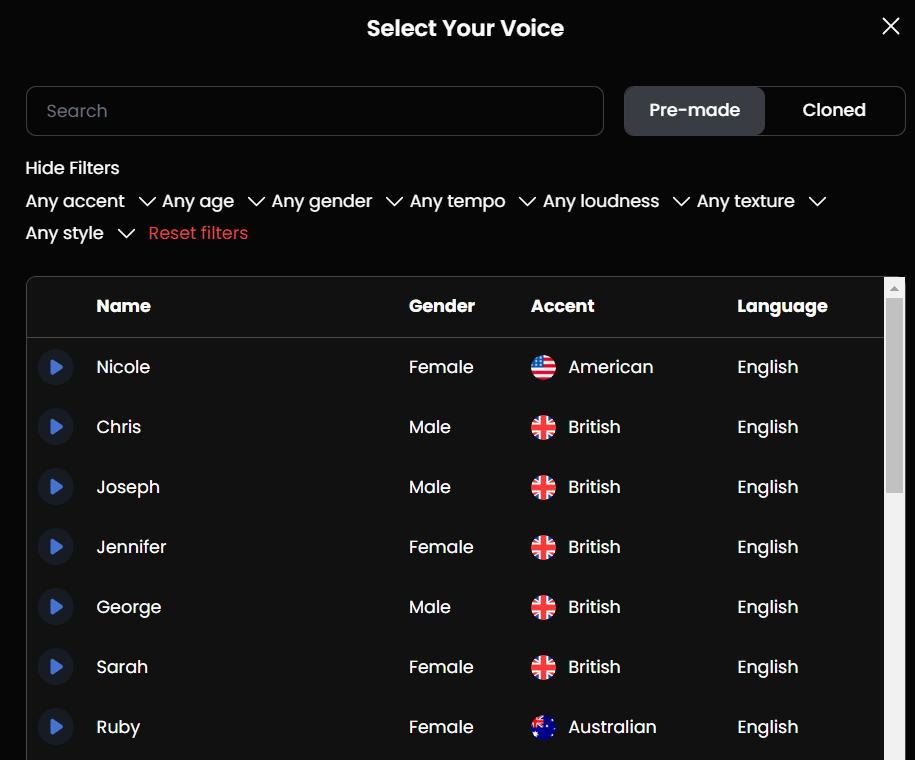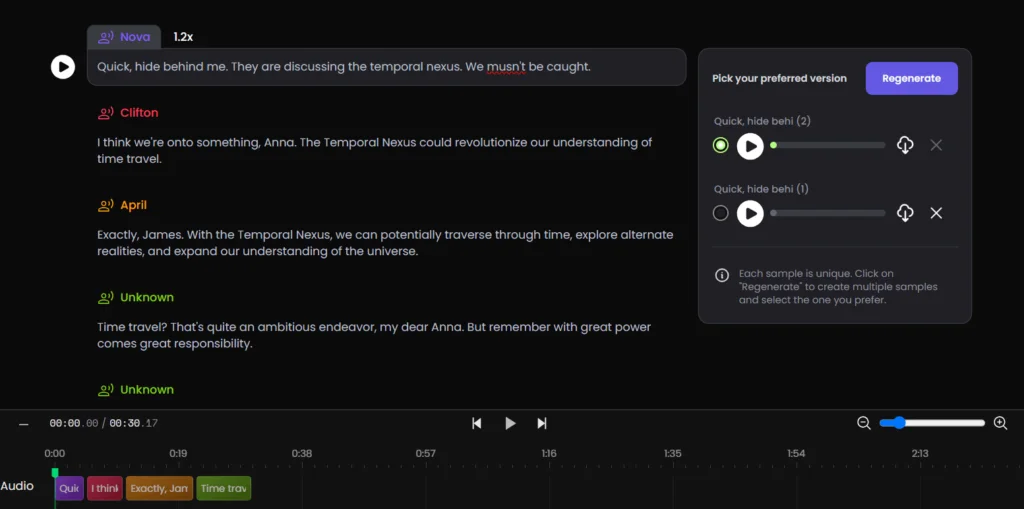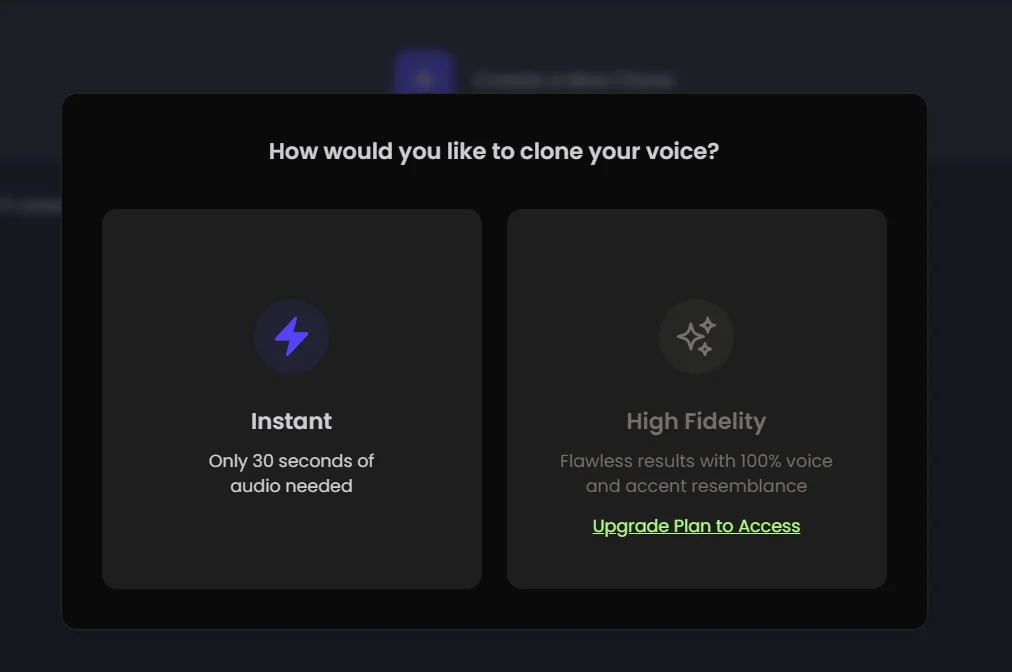
Elevenlabs is a great AI voice generator but it comes with a hefty price tag and a fairly barebones user interface.
Here, you will find unlimited & free Elevenlab alternatives:
- Free Text-to-Speech tools plus open-source options
- Fast and unlimited voice generation
- Easy to setup (no-code or low-code)
Here my top 3 free AI voice generators. Keep reading for a detailed overview.
| Tool | Best For |
|---|---|
| Coqui TTS | General purpose voice generation; fantasy screenplays; their xtts-v2 (huggingface link) model reaches 11lab quality in voice cloning; each model comes with its own usage terms (XTTS is non-commercial) |
| Mycroft Mimic3 | Personal voice assistant; Works offline |
| Tortoise | Best quality but slow (Alternative: Playht turbo, a faster freemium TTS) |
For those who prioritize user interfaces and additional features, and don’t mind exploring plans that might come with costs, check out our roundup of the Best AI Voice Generators with free plans available.
If you are okay with writing python code, open AI TTS is 6x cheaper than Eleven Labs and just as good:
1. Coqui TTS
Meet Coqui TTS. It’s a simple tool that helps you turn text into speech. You can start for free with its Python library which supports 100s of TTS models.

Key Features
- Easy to use: Available as a free python library, and paid API and webapp.
- Multilingual: Supports 13 languages.
- Multi-speaker TTS: Add multiple characters to voiceover.
- Advanced timeline editor: Adjust pitch, loudness and emotions, for each sentence, word or character.
- Voice cloning: Clone any voice from 3 seconds of audio and add to your collection.
- Prompt 2 Voice: Generate voices from prompt.
- Support for large number of TTS models including:
- Tortoise
- Bark
- Tacotron
- Fastspeech and more.
- xtts-v2
Note: The Coqui code is released under the MPL license. What does this mean? The TTS code and models have explicit licenses. TTS as a code base is under MPL2.0 (allows commercial use) and each model has its own license (may not allow commercial use). The model creator chooses the license.
Example: models from Meta are under a Creative Commons non-commercial license. But the XTTS Model does not allow you to use it commercially without paying for a license. 😢You can buy a commercial use license from Coqui.
Pros
- Easy-to-use colab notebook.
- Multiple emotional tones and styles
- You can generate your own voices from text prompts plus fuse two voices using Voice fusion.
- Voice cloning is fast and high quality.
- Best voices for fantasy/storytelling use cases.
Cons
- Commercial license for XTTS model is paid.
2. Bark by Suno.ai
Bark is like your personal studio for creating voices and music. You don’t need to pay anything to get started.
Key Features
- Lots of Choices: Over 100 voice presets to pick from, plus new ones from other users on Discord.
- Smart Language Handling: Bark can handle texts in many languages, even if they’re mixed together.
- Sings Too: Not just talk—Bark can create singing voices.
Pros
- Sounds Real: Whether it’s speaking in different languages or making music, Bark sounds like the real thing.
- Expressive: It can laugh, sigh, cry—just like a person.
- Commercial Use: You can use Bark for your projects, even to make money.
- Community Support: Join the Discord to meet others and find new voice presets.
- Big Library: There’s a huge collection of voice prompts to explore.
Cons
- No Web App Yet: You’ll need to use Colab or Discord to try it out for now, but it’s still free and easy.
3. Tortoise TTS
Tortoise TTS is all about making text sound as natural as it can get. It’s a text-to-speech model that James Betker designed to make voices that sound really true-to-life.
Key Features
- High Fidelity Voice Cloning: Create voices that sound just like the input audio sample.
- Realistic AI Voiceovers: Make your text come to life with voices that are hard to tell apart from real humans.
- Elevenlab reportedly uses a fine-tuned clone of Tortoise TTS.
Pros
- Top-Notch Voices: The voices you can create are super clear and sound great.
- Master at Cloning: It’s really good at making new voices from just a small bit of audio from someone. This is perfect for making lots of different voices, even famous ones.
- Quality Voices: The voices you make with it are of very high quality.
- Control How It Speaks: You can adjust how the voice talks—its tone, feeling, speed, and more—by changing the text prompt you give it (Like typing “I am sad” in text makes the ai voice sound sadder).
Cons
- Just English: Right now, it can only make voices in English and can’t make sound effects.
- It can be tough to get it set up and it’s pretty slow.
James stopped working on Tortoise (at least in public) in view of ethical considerations (the model is really good, and he fears it may be used for fraud if optimized for faster output). But it is still a good model to try out and to read through the code from an engineering standpoint.
4. Play.ht Playground
Play.ht gives you a world of voices—907 AI voices in 142 languages and accents. It’s great for reaching a wide audience, from local dialects to global languages.
Including this because at time of writing their free plan is pretty generous. But this is not open source.
Key Features
- Lots of Voices: Play.ht has a huge library of 907 AI voices that cover 142 languages and accents. That means you can find the perfect voice for any audience, including local languages like Malayalam and Telugu.
- Just Like Real: The voices are made to sound just like a person’s voice. This is great for when you want someone to listen to your audiobook or learn something new and feel like someone real is talking to them.
- Pick Your Voice Style: No matter what you’re making—a news report, a chat with customers, or anything else—there’s a voice style ready for you. You can choose from styles like Newscaster, Conversational, or Customer Support, among others.
- Clone Voices Well: If you need a voice that sounds like a specific person, you can clone it with Play.ht. This is an extra feature you can add on, and it does a really good job of copying voices.
- SEO-Optimized Audio Articles: Enhance your website’s accessibility and search engine presence by converting text articles into audio formats using Play.ht’s convenient audio widget.
- Custom Pronunciation Library: Address the common issue of mispronunciation by voice generators by building a custom pronunciation guide within Play.ht, ensuring your audio content sounds just right.
- Direct Podcast Distribution: Streamline your workflow by distributing your audio directly to popular platforms such as iTunes, Spotify, and Google Podcasts from the Play.ht dashboard, eliminating the need for multiple upload/download steps.
Pros
- Precision in Pronunciation: It excels in accurately pronouncing technical words and acronyms, making it pretty useful for educational content.
- Generous Free Tier: Dip your toes in with a free plan that includes 2500 words.
- Word Limit Flexibility: With basic plans offering 3 million characters per year, you won’t easily run out of capacity.
- Authenticity in Voices: The ultra-realistic voices are fine-tuned to closely mimic human intonation and emotion.
- Multilingual Voice Cloning: Not only does it clone voices, but it does so across multiple languages, a feature not commonly found elsewhere.
- Diverse Language Support: Extensive collection of non-English language options, like Hindi.
Cons
- The starting plan is at $30, which might be steep for users with minimal voiceover needs.
5. Mycroft Mimic 3
Mimic 3 is a tool that respects your privacy and is completely open-source, which means anyone can use or modify it.
It’s a neural Text to Speech (TTS) engine, designed to deliver high-quality voice output that you can use right from your own devices, without needing an internet connection.
They’re also working on a cloud version for those who prefer simplicity or have devices with limited processing power.
Pros
- Quality Voices: The voice output is clear and natural-sounding.
- It can run completely offline.
- Suitable for low-end hardware.
Cons
- Voices are not very expressive.
6. silero-models
Silero Models offers pre-trained models that make Speech-to-Text (STT) and Text-to-Speech (TTS) tasks straightforward for businesses.
They pride themselves on providing STT services that are on par with, and sometimes even surpass, the quality of Google’s offerings, all without the complexity typically associated with such technology.
Key Features
- High-Quality STT: Their Speech to Text is refreshingly easy to use—just check their benchmarks (on Github) to see how they stack up against the competition.
- Hassle-Free TTS: Silero provides Text to Speech models that are ready to use with just one line of code, boasting a broad selection of voices and a simple, dependency-free setup.
- Efficient and Fast: These models are optimized for speed, running faster than real-time speech on a single CPU thread, with support for both 16kHz and 8kHz audio.
Pros
- No Complex Setup: You won’t need to deal with Kaldi, compilations, or lengthy instructions to get started.
- High-Performance Speech: The end-to-end pipeline ensures the speech sounds natural, and you don’t need a GPU or any training to begin.
- Language Support: It supports Russian, English, German, and Spanish, and has the potential to be extended further.
- Text Readability: Their model can insert punctuation and capitalization effectively, making texts more readable.
7. MockingBird
MockingBird is a Python-based project that specializes in cloning voices quickly—just 5 seconds—and enables the generation of speech in real time. It’s built for working with Chinese, providing seamless real-time voice cloning.
Key Features
- Chinese Language Support: Works with Mandarin and tested on several datasets (aidatatang_200zh, magicdata, aishell3, data_aishell).
- PyTorch Compatibility: Good to go with PyTorch 1.9.0 and performs well on NVIDIA GPUs like Tesla T4 and GTX 2060.
- Cross-Platform Functionality: Runs on Windows, Linux, and even M1 MACOS.
- User-Friendly and High-Quality: Easy to get started with just a new synthesizer training, using a pre-trained encoder/vocoder for quality voice cloning.
- Webserver Integration: Ready to roll for online use, letting you serve up voice clones and manage them remotely.
MockingBird stands out for its rapid voice cloning capability, particularly for Chinese Mandarin, and its ease of use across different platforms and technologies.
8. Microsoft VALL-E-X
VALL-E-X is a Python project that implements Microsoft’s VALL-E X zero-shot TTS model, which can generate speech in any language without any training data.
Key Features
- Zero-shot TTS: Can generate speech in any language without prior training data.
- In-context Learning: Adapts to new voices and languages swiftly using just a 3-second speech sample.
- High Performance: Surpasses other systems in naturalness and speaker similarity.
- Emotion and Environment Preservation: Retains the original speaker’s emotion and the recording’s acoustic quality.
- Multilingual Capabilities: Enables cross-lingual synthesis and speech-to-speech translation while maintaining voice characteristics.
9. Pyttsx3
Pyttsx3 is a versatile text-to-speech library that works seamlessly with both Python 2 and 3. It’s a reliable tool for offline speech generation, supporting various TTS engines and allowing users to create speech without the need for an internet connection.
Key Features
- Offline Capability: Functions without the need for an internet connection.
- Supports Multiple TTS Engines: Compatible with Sapi5, nsss, and espeak.
- Cross-Version Support: Works with older and newer versions of Python.
10. Nvidia NeMo
vidia NeMo is a powerful toolkit for those in the field of conversational AI. This Python-based project offers resources for speech recognition, synthesis, natural language processing, and more, making it an essential tool for both researchers and developers.
Key Features
- Conversational AI Focus: Designed specifically for speech and language models.
- Comprehensive Toolkit: Includes support for ASR, TTS, LLMs, and NLP.
- Research-Friendly: Facilitates the reuse and development of conversational AI models.
- Pretrained Models: Offers a range of pretrained models to accelerate development.
11. DiffSinger
DiffSinger is a pioneering Python project that implements a neural model dedicated to creating synthetic singing voices. It’s designed to generate a singing voice that can be customized and controlled, offering new possibilities for digital music production.
Key Features
- Neural Singing Voice Synthesis: Specializes in generating digital singing voices.
- Model Control: Allows for fine-tuning and personalization of the synthetic voice.
- 5 Best No-Code App Builders 2024 (used by actual startups) - June 15, 2024
- 5 Successful No Code Startups and Companies 2024 (with Tech Stack) - January 26, 2024
- AI Sleeper Agents: Latest Danger to AI Safety (Anthropic Research) - January 20, 2024



